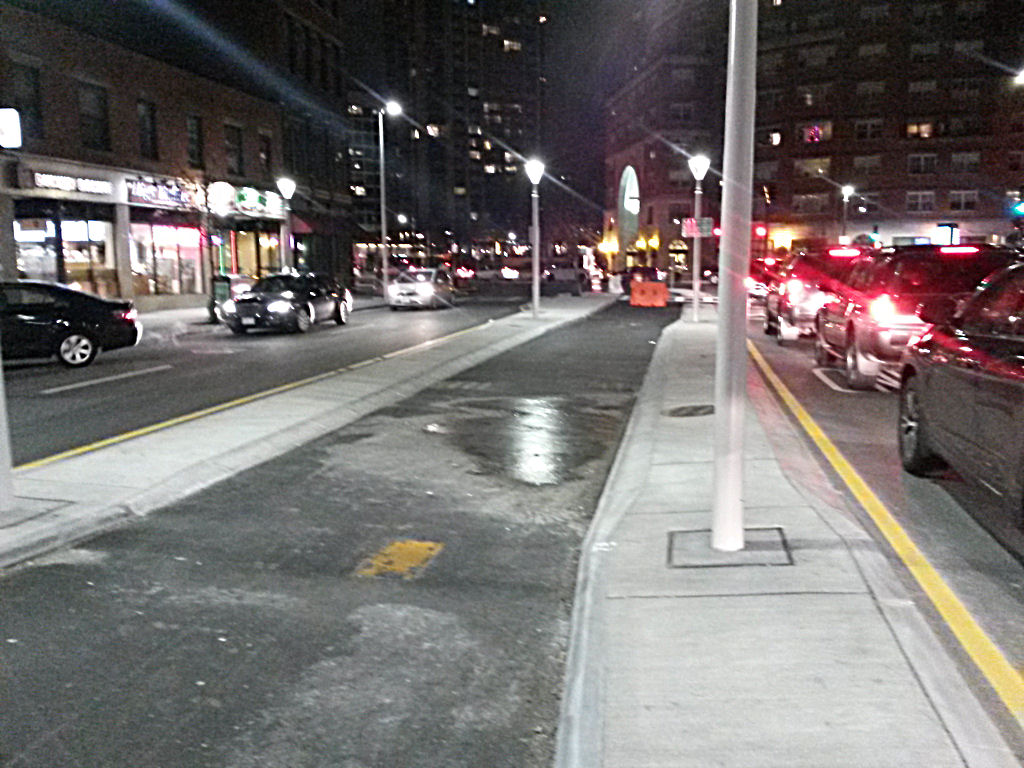I took the photo below around 10 PM on January 5, 2017 looking west on Causeway Street in Boston from in front of North Station. Here’s a link to the location in Google maps. The default view in Google Maps is from before installation of the bikeway, as I write this.

Ice patch , Causeway Street bikeway, January 5, 2017
Streets are crowned (higher in the middle) so water drains off. In winter, the center of the street clears once plowed, and stays free of ice even when plowed snow is piled in the gutters.
The bikeway in the middle of Causeway Street, not opened yet, has two storm drains visible in the photo, just behind the ice patch which extends most of the of the way across. The drains are not at the lowest point. Only heavy and continuous salting could keep ice from forming at this low point when water drains off the concrete barriers and freezes. The barriers slope toward the bikeway.
The barrier on the left also impedes access to Lancaster Street (where the black car is turning out of the photo), the most convenient way to get to Merrimack Street and head toward downtown Boston from North Station on a bicycle. The concrete medians have mountable curbs opposite Lancaster Street so emergency vehicles can cross over the bikeway, but turning across one of these barriers on a bicycle could be dicey when icy, and require dismounting to get over a pile of snow.
The problem here reflects construction error, in that the lowest spot along the bikeway does not match the location of the storm drains — but there are some larger lessons to draw from this failure.
Much in street design rests on long experience and tradition. Civil engineers know how to crown and drain a street so well that design failure is rare. Design elements are robust enough that minor construction errors — say, a drain which is not precisely at the bottom of a dip — are unimportant. A puddle or ice patch may form but it is in the gutter where it doesn’t pose a serious problem. As already mentioned, the street will still drain if snow is piled at its edges. When snow is melting, meltwater usually will undercut it and find the storm drains.
But the bikeway here is much narrower and there is is much less room for error. Traditional techniques and equipment fail to accomplish what is needed. Placement of drains is much more critical. Paving machines are not designed to produce the smaller-radius crowning which would carry water to the edges. Even with crowning, the water would intrude into traveled width of the bikeway.
A well-designed shared-use path has a sideslope and will drain onto a grassy area on one side. This practice is well-known, though not always applied in practice. A sidewalk or Copenhagen-style raised bikeway adjacent to a street, if designed to drain properly, also has a sideslope, so water drains down the curb into the street. Most American urban sidewalks apply this design principle, as well they must. If they drained away from the street, they would flood the buildings alongside. The building owners and tenants would be unhappy, to say the least. But, if part of a roadway’s width is reconfigured into a sidewalk or bikeway, all the drains have to be moved, and that is expensive.
Most American on-street barrier-separated bikeways, even those at the edge of the street, were installed as retrofits, afterthoughts, and do not drain properly. I have an example of another bikeway with this problem online. A couple of bikeway projects in Cambridge, as much as I may have other problems with them, were installed in connection with street reconstruction which replaced all the drains. This worked for the bikeway on the south side of Concord Avenue — though not for the one on the north side, where many obstacles prevent proper drainage and snow removal. Blogger David Chase has posted about this.
A median bikeway between barriers, like the one here, could possibly drain if the surface had been left at its original height, or raised, with a sideslope and frequent cut-throughs in the barriers. That approach would avoid the need for additional drains. Snow would still pose a problem. The conventional waffle-iron drains here, without a sideslope, fail. Bicyclists will be riding through a puddle during and after every rain; through sand after snow has melted; and through ice after a freeze.
The problem here may be considered as one of engineering but also of politics, reflecting a rush to install special infrastructure for bicycling when the expertise and political will to apply best practices are lacking. This problem is especially acute in the USA but it also occurs in countries which are usually singled out as exemplary. As a general rule, it might be stated that planning and design of bicycling infrastructure reflect funding limitations, political pressure to “do something,” and planning, engineering and construction work which are behind the curve on best practices.
All of these issues arise with the Connect Historic Boston project, of which the bikeway on Causeway Street is one segment, and I have addressed the project more generally in previous posts on this blog.
Save

